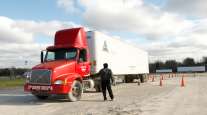OEMs: 2017 Greenhouse Rule Could Limit Customer Options
This story appears in the Nov. 5 print edition of Transport Topics.
CINCINNATI — Truck and engine makers said that meeting the federal government’s greenhouse-gas standards that take effect in 2017 while still complying with the 2010 emissions rule is a difficult challenge and could result in more “hard programming” of engine settings and fewer choices for fleets in their tractors.
During an industry meeting here, executives presented a list of technological options they may pursue in coming years, and they generally agreed that complying with the two rules simultaneously — within the confines of a standard truck cab and while giving some deference to cost containment — is a significant challenge.
“This truck is about maxed out,” said Jason Krajewski, fuel consumption engineer for Daimler Trucks North America, referring to the Freightliner Cascadia. Since the truck was introduced in 2007, Krajewski said, DTNA has reduced fuel consumption by 15%. The work has allowed Freightliner to certify the vehicle for the 2014 greenhouse standard more than a year in advance.
Hitting the 2017 mark on time is not at all impossible, Krajewski said, but it will take new technological developments.
The discussion took place Oct. 30 at the Integer Research conference on diesel emissions and diesel exhaust fluid.
When the U.S. Environmental Protection Agency issued regulations to limit nitrogen oxides and particulate matter, manufacturers had to make engines less efficient in order to reduce emissions. For greenhouse-gas reduction, the strategy is now to lower emissions by increasing fuel economy.
“Cafeteria-style spec’ing for trucks is long gone. Life is a large compromise,” said Bill Dawson, a North American senior vice president of Volvo Trucks.
Volvo plans to meet the 2017 GHG standard — 3% tighter than the first round in 2014 — without resorting to hard programming in the engine for a mandatory, anti-idling shutdown, he said.
Truck owners have long been able to program the engine control modules in their tractors to perform in certain ways, such as a maximum speed, but hard programming is designed for permanence and is not supposed to be overridden.
Truck engineers have described the pursuit of fuel economy as a painstaking layering on of small improvements, as no blockbuster developments were anticipated.
“Diesel has been around for 100 years, so trying to get a little more efficient now is like trying to get blood from a stone,” said Charles Roberts, institute engineer at Southwest Research Institute.
Participants in the Integer conference said EPA has suggested as possible options for 2017 hard programming of engines to cap speeds around 65 miles per hour or less, or to shut down engines after a certain amount of idling, perhaps five to 10 minutes.
Volvo’s Dawson said OEMs don’t like the idea of forcing customers to accept features, but that might be necessary in some cases.
In order to comply with greenhouse-gas standards, OEMs will have to demonstrate to EPA that their average truck sold in a given class performs at a certain level, Dawson said.
Ken Federle, executive director of product engineering for Cummins Emission Solutions, said selective catalytic reduction technology is still far from its mature, optimal state and might be able to make a significant contribution.
“Aftertreatment [SCR] can do a lot of heavy lifting for the engine,” said Federle, who offered a model for cost, size and performance of SCR systems. All three goals could be pursued simultaneously, to an extent, he said, although pushing hard on one or two aspects probably means the third factor would have to buckle.
Federle offered exhaust gas recirculation as an example. He said some European manufacturers will drop the use of EGR as an in-cylinder NOx reduction technique and do all of their NOx reduction through SCR. Such engines would burn hot and not need diesel particulate filters, he said.
Federle said that change would be almost impossible in the United States, where standards are stricter, but it does mean U.S. engine makers at least could reduce EGR levels, which well could lead to greater fuel economy.
All executives mentioned turbo compounding and other methods of waste-heat recovery, where engine heat is captured and put to use turning a turbine or other work in power generation.
Cummins has been working on waste-heat recovery for about 10 years, Federle said, and it is coming close to being commercially feasible. He said the system probably would cost about $8,000 to $12,000 per truck and pay for itself in 18 to 24 months, assuming that diesel costs between $4.25 and $5 a gallon.



